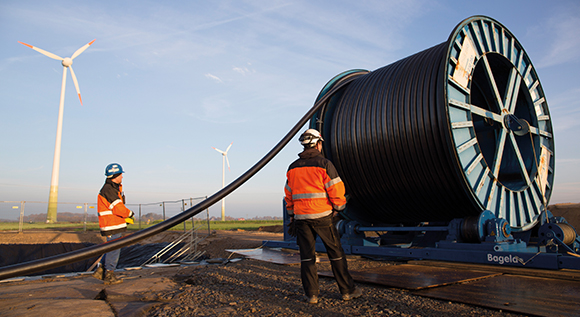Progress on route planning
Half of the new kilometres of grid set out in the Power Grid Expansion Act have been approved and planning for the SuedLink and SuedOstLink electricity highways is going into the next phase.
 © Bundesnetzagentur
© Bundesnetzagentur
The share of renewable energy in the electricity mix is growing. This means we need to expand the transmission grid. In the past, local power plants tended to supply surrounding areas with electricity. Today, it is generated for example from wind energy, particularly from North and East Germany, where the wind is strongest. However, the largest electricity consumers, first and foremost industrial companies, are based in the South and West. The grid expansion is therefore of great importance for the energy transition. We must improve, upgrade and build more than 7,500 kilometres of grid in the coming years.
This work is based on the existing network and 22 particularly important projects, as listed in the demand plan set out under the Power Grid Expansion Act. The Federal Government has now taken stock. The status at the end of the first half of 2016: a third of the necessary 1,800 kilometres of grid have already been put in place; almost half of them have been approved. The Federal Government provides information in a progress report for the Bundestag.
State Secretary Baake: ‘This is a significant milestone.’
‘The grid expansion is slowly but surely picking up speed’, said Rainer Baake, State Secretary at the Federal Ministry for Economic Affairs and Energy. ‘Even though the number of successfully implemented projects, at a total of 650 kilometres, is still too low, around 850 kilometres have been approved, representing approximately 50 per cent of the projects set out under the Power Grid Expansion Act. This is a significant milestone. Everyone now needs to keep doing all they can to drive the projects forward.’
The Länder are responsible for approving the projects. It is the responsibility of the four German transmission system operators (TSOs) to submit applications for, construct and operate the electricity lines. The TSOs expect around 45 per cent of the 1,800 kilometres of grid planned under the Power Grid Expansion Act to be completed by the end of 2017 and around 85 per cent by the end of 2020.
Pursuant to the Federal Requirements Plan Act, another 43 projects are needed that build on the existing network and the 22 projects mentioned above.
The aim is to involve the public from an early stage
The plans for the large SuedLink and SuedOstLink electricity highways, which run from Schleswig-Holstein and Saxony-Anhalt to Bavaria, are taking shape. Pursuant to the Federal Requirements Plan Act, TSOs TenneT, TransnetBW and 50Hertz have now proposed corridors for the power line routing.
The operators want to involve the public in the planning even before they apply for federal sectoral planning at the Federal Network Agency, thereby launching the official procedure. According to the Federal Network Agency, the submission of applications is planned for early next year. The Federal Ministry for Economic Affairs and Energy welcomes the idea of involving the public at an early stage. Citizens will, of course, have many possibilities to participate later on while the official procedure is being conducted.
Underground cables are the priority
According to the recently published plans of the TSOs, the two SuedLink and SuedOstLink HVDC transmission lines (more information on these can be found in the following article) will run completely underground. The priority of underground cables over overhead power lines for these electricity highways was enshrined in law last year. Even though underground cables are more expensive, they enjoy greater public acceptance than overhead power lines, due to their having less of an impact on the surrounding landscape. The Federal Ministry for Economic Affairs and Energy therefore expects the planning phase to be completed soon and that the SuedLink and SuedOstLink can enter into service in 2025.
While the exact line routing has not yet been determined, the start and end points of the electricity highways have been prescribed by the government. The SuedOstLink will run from Wolmhirstedt near Magdeburg in Saxony-Anhalt to Isar, a region in Bavaria near Landshut. The SuedLink begins near the cities of Brünsbüttel and Wilster in Schleswig-Holstein and ends in two locations: one in Grafenrheinfeld in Bavaria, the other in Großgartach near Heilbronn in Baden-Württemberg.
Dialogue phase for A-Nord project launched
The TSO Amprion launched its first dialogue phase for another electricity highway at the beginning of October. The TSO is involving the public in its work to find the best possible route for the A-Nord DC line between Emden Ost at the North Sea and the Osterath region in North Rhine-Westphalia. No proposal is currently on the table for the route of this project.

